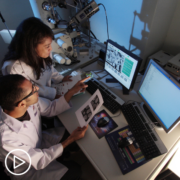Understanding CAR T-Cell Therapy | How It Works and Who It’s Right For
Understanding CAR T-Cell Therapy | How It Works and Who It’s Right For from Patient Empowerment Network on Vimeo.
How is CAR T-cell therapy changing myeloma care? Dr. Adriana Rossi explains how CAR T-cell therapy works to fight myeloma and which patient type is most appropriate for this treatment option.
Dr. Adriana Rossi is co-director of the CAR T and stem cell transplant program at the Center for Excellence for Multiple Myeloma at Mount Sinai Health System in New York City. Learn more about Dr. Rossi.
See More From Thrive CAR T-Cell Therapy
Related Resources:

|

|

|
Transcript:
Katherine Banwell:
Since we’ll be discussing the ins and outs of CAR T-cell therapy, I thought we could start with your perspective as a researcher in the field. How has this therapy revolutionized myeloma care?
Dr. Adriana Rossi:
It absolutely has. And I would say in time we’ve had – this is now our fourth revolution. Stem cell transplants was the first time we actually achieved what we call a complete remission in at least a few patients, making myeloma disappear.
Then, we had the second revolution with the novel agents. Now, we had drug therapies that were giving us these complete remission still at about a 30 percent rate. And then, the monoclonal antibodies were the most recent revolution. And currently, we are in what we call the T-cell redirection.
It really has been driven by CAR T-cell therapies and something we call bispecific antibodies, which also use your patient’s T cells to kill the myeloma. We are now seeing absolutely unprecedented response rates, meaning almost everybody is responding. Also, depth of response, which we have really learned over time is a way to translate into long remissions. So, every long, very significant remissions. And the early data in patients who have had many prior lines.
Katherine Banwell:
So, it is very encouraging news.
Dr. Adriana Rossi:
It is very encouraging.
Katherine Banwell:
Let’s start with an overview of CAR T-cell therapy. Could you explain how the treatment works?
Dr. Adriana Rossi:
Absolutely. So, CAR T specifically is speaking to T cells, which are a normal part of the immune system that have been engineered and modified. So, normal part of the immune system T cells have a lot of checks and balances and are constantly looking for cells that are supposed to be killed. For example, something that has a virus in it.
When we engineer the CAR T-cells, we modify, one, the target so they are now trained to find the specific target on a tumor cell. And we remove all these checks and balances. So, once that T-cell finds its target, it can kill it without all of the side effects. The way normal T cells communicate with other members of the immune system are something called cytokines. So, we will touch on that a little later, I think, but we also, again, interfere with that communication by engineering the cells.
Katherine Banwell:
Which patient type qualifies for CAR T?
Dr. Adriana Rossi:
In 2023, we currently have two approved commercial CAR T products and we do have a number of them in clinical trials. The two that are commercially approved specifically are targeted for patients who are in their fourth line of therapy, so the myeloma has learned to come back that four times.
They’ve been exposed to all of the regular drugs, which by four lines most patients will have been at least once. We look for patients whose kidney function is at a safe level to tolerate the therapy. And other than that, it’s really having caregiver support and overall ability to come to a center that specializes in this.










